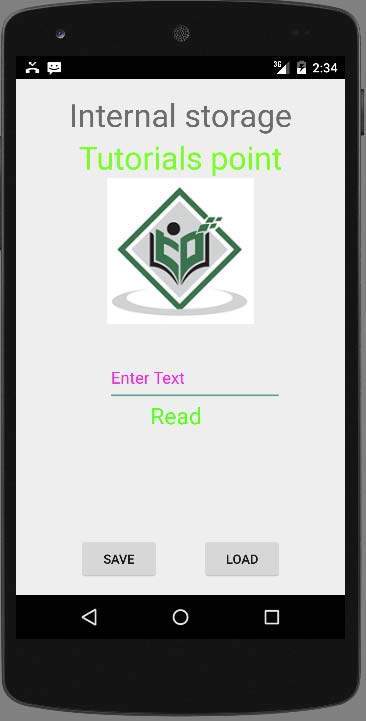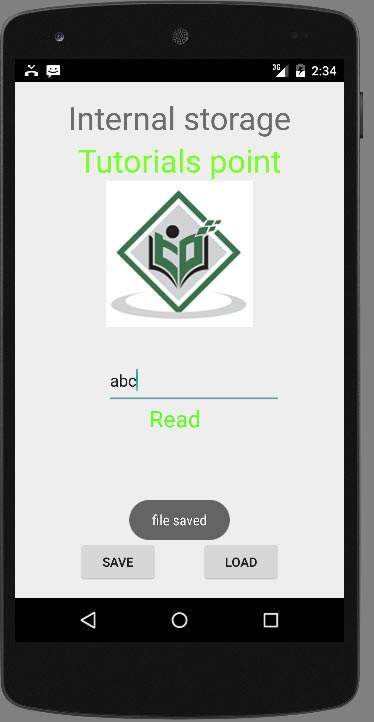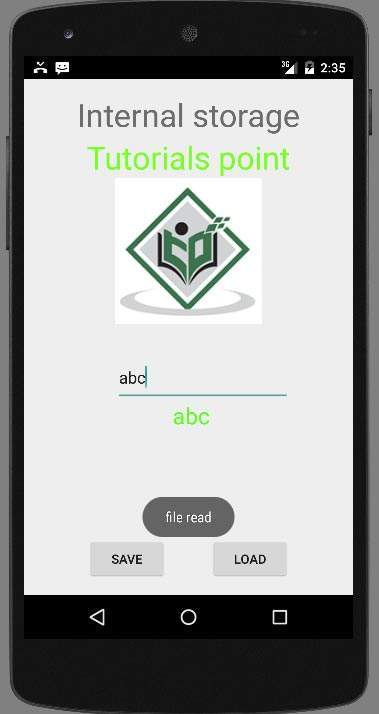
- Android 基礎
- Android - 首頁
- Android - 概述
- Android - 環境設定
- Android - 架構
- Android - 應用元件
- Android - HelloWorld 示例
- Android - 資源
- Android - 活動 (Activities)
- Android - 服務 (Services)
- Android - 廣播接收器 (Broadcast Receivers)
- Android - 內容提供者 (Content Providers)
- Android - 碎片 (Fragments)
- Android - 意圖/過濾器 (Intents/Filters)
- Android - 使用者介面
- Android - UI 佈局
- Android - UI 控制元件
- Android - 事件處理
- Android - 樣式和主題
- Android - 自定義元件
- Android 高階概念
- Android - 拖放
- Android - 通知
- 基於位置的服務
- Android - 傳送電子郵件
- Android - 傳送簡訊
- Android - 打電話
- 釋出 Android 應用
- Android 有用示例
- Android - 警報對話方塊
- Android - 動畫
- Android - 音訊捕獲
- Android - AudioManager
- Android - 自動完成
- Android - 最佳實踐
- Android - 藍牙
- Android - 相機
- Android - 剪貼簿
- Android - 自定義字型
- Android - 資料備份
- Android - 開發者工具
- Android - 模擬器
- Android - Facebook 整合
- Android - 手勢
- Android - Google 地圖
- Android - 圖片特效
- Android - ImageSwitcher
- Android - 內部儲存
- Android - JetPlayer
- Android - JSON 解析器
- Android - LinkedIn 整合
- Android - 載入微調器
- Android - 本地化
- Android - 登入介面
- Android - MediaPlayer
- Android - 多點觸控
- Android - 導航
- Android - 網路連線
- Android - NFC 指南
- Android - PHP/MySQL
- Android - 進度圓圈
- Android - ProgressBar
- Android - 推送通知
- Android - RenderScript
- Android - RSS 閱讀器
- Android - 螢幕錄製
- Android - SDK 管理器
- Android - 感測器
- Android - 會話管理
- Android - 共享首選項
- Android - SIP 協議
- Android - 拼寫檢查器
- Android - SQLite 資料庫
- Android - Support Library
- Android - 測試
- Android - 文字轉語音
- Android - TextureView
- Android - Twitter 整合
- Android - UI 設計
- Android - UI 模式
- Android - UI 測試
- Android - WebView 佈局
- Android - Wi-Fi
- Android - 小部件
- Android - XML 解析器
- Android 有用資源
- Android - 問答
- Android - 有用資源
- Android - 討論
Android - 內部儲存
Android 為應用程式提供多種儲存方式來儲存其資料。這些儲存位置包括共享首選項、內部和外部儲存、SQLite 儲存以及透過網路連線進行儲存。
本章我們將瞭解內部儲存。內部儲存是在裝置記憶體中儲存私有資料。
預設情況下,這些檔案是私有的,只能被您的應用程式訪問,並且在使用者刪除您的應用程式時會被刪除。
寫入檔案
為了使用內部儲存將一些資料寫入檔案,請使用檔名和模式呼叫 openFileOutput() 方法。模式可以是 private、public 等。其語法如下:
FileOutputStream fOut = openFileOutput("file name here",MODE_WORLD_READABLE);
openFileOutput() 方法返回 FileOutputStream 的一個例項。因此,您可以在 FileInputStream 物件中接收它。之後,您可以呼叫 write 方法將資料寫入檔案。其語法如下:
String str = "data"; fOut.write(str.getBytes()); fOut.close();
讀取檔案
為了讀取您剛剛建立的檔案,請使用檔名呼叫 openFileInput() 方法。它返回 FileInputStream 的一個例項。其語法如下:
FileInputStream fin = openFileInput(file);
之後,您可以呼叫 read 方法一次讀取一個字元,然後列印它。其語法如下:
int c;
String temp="";
while( (c = fin.read()) != -1){
temp = temp + Character.toString((char)c);
}
//string temp contains all the data of the file.
fin.close();
除了 write 和 close 方法外,FileOutputStream 類還提供其他方法來更好地寫入檔案。這些方法列在下面:
| 序號 | 方法及說明 |
|---|---|
| 1 |
FileOutputStream(File file, boolean append) 此方法構造一個新的 FileOutputStream,該方法寫入檔案。 |
| 2 |
getChannel() 此方法返回一個只寫 FileChannel,它與該流共享其位置。 |
| 3 |
getFD() 此方法返回底層檔案描述符。 |
| 4 |
write(byte[] buffer, int byteOffset, int byteCount) 此方法將從位元組陣列緩衝區中從偏移量位置開始的 count 個位元組寫入此流。 |
除了 read 和 close 方法外,FileInputStream 類還提供其他方法來更好地讀取檔案。這些方法列在下面:
| 序號 | 方法及說明 |
|---|---|
| 1 |
available() 此方法返回可以讀取或跳過而不阻塞更多輸入的位元組數的估計值。 |
| 2 |
getChannel() 此方法返回一個只讀 FileChannel,它與該流共享其位置。 |
| 3 |
getFD() 此方法返回底層檔案描述符。 |
| 4 |
read(byte[] buffer, int byteOffset, int byteCount) 此方法最多從此流中讀取 length 個位元組,並將它們儲存在從 offset 開始的位元組陣列 b 中。 |
示例
這是一個演示使用內部儲存來儲存和讀取檔案的示例。它建立一個基本的儲存應用程式,允許您讀取和寫入內部儲存。
要試用此示例,您可以在實際裝置或模擬器上執行它。
| 步驟 | 描述 |
|---|---|
| 1 | 您將使用 Android Studio IDE 在包 com.example.sairamkrishna.myapplication 下建立一個 Android 應用程式。 |
| 2 | 修改 src/MainActivity.java 檔案以新增必要的程式碼。 |
| 3 | 修改 res/layout/activity_main 以新增相應的 XML 元件。 |
| 4 | 執行應用程式,選擇正在執行的 Android 裝置,將應用程式安裝在其上並驗證結果。 |
以下是修改後的主活動檔案 src/MainActivity.java 的內容。
package com.example.sairamkrishna.myapplication;
import android.app.Activity;
import android.os.Bundle;
import android.view.View;
import android.widget.Button;
import android.widget.EditText;
import android.widget.TextView;
import android.widget.Toast;
import java.io.FileInputStream;
import java.io.FileOutputStream;
public class MainActivity extends Activity {
Button b1,b2;
TextView tv;
EditText ed1;
String data;
private String file = "mydata";
@Override
protected void onCreate(Bundle savedInstanceState) {
super.onCreate(savedInstanceState);
setContentView(R.layout.activity_main);
b1=(Button)findViewById(R.id.button);
b2=(Button)findViewById(R.id.button2);
ed1=(EditText)findViewById(R.id.editText);
tv=(TextView)findViewById(R.id.textView2);
b1.setOnClickListener(new View.OnClickListener() {
@Override
public void onClick(View v) {
data=ed1.getText().toString();
try {
FileOutputStream fOut = openFileOutput(file,MODE_WORLD_READABLE);
fOut.write(data.getBytes());
fOut.close();
Toast.makeText(getBaseContext(),"file saved",Toast.LENGTH_SHORT).show();
}
catch (Exception e) {
// TODO Auto-generated catch block
e.printStackTrace();
}
}
});
b2.setOnClickListener(new View.OnClickListener() {
@Override
public void onClick(View v) {
try {
FileInputStream fin = openFileInput(file);
int c;
String temp="";
while( (c = fin.read()) != -1){
temp = temp + Character.toString((char)c);
}
tv.setText(temp);
Toast.makeText(getBaseContext(),"file read",Toast.LENGTH_SHORT).show();
}
catch(Exception e){
}
}
});
}
}
以下是修改後的 xml 檔案 res/layout/activity_main.xml 的內容。
在以下程式碼中,abc 表示 tutorialspoint.com 的徽標。
<?xml version="1.0" encoding="utf-8"?>
<RelativeLayout xmlns:android="http://schemas.android.com/apk/res/android"
xmlns:tools="http://schemas.android.com/tools" android:layout_width="match_parent"
android:layout_height="match_parent" android:paddingLeft="@dimen/activity_horizontal_margin"
android:paddingRight="@dimen/activity_horizontal_margin"
android:paddingTop="@dimen/activity_vertical_margin"
android:paddingBottom="@dimen/activity_vertical_margin" tools:context=".MainActivity">
<TextView android:text="Internal storage" android:layout_width="wrap_content"
android:layout_height="wrap_content"
android:id="@+id/textview"
android:textSize="35dp"
android:layout_alignParentTop="true"
android:layout_centerHorizontal="true" />
<TextView
android:layout_width="wrap_content"
android:layout_height="wrap_content"
android:text="Tutorials point"
android:id="@+id/textView"
android:layout_below="@+id/textview"
android:layout_centerHorizontal="true"
android:textColor="#ff7aff24"
android:textSize="35dp" />
<Button
android:layout_width="wrap_content"
android:layout_height="wrap_content"
android:text="Save"
android:id="@+id/button"
android:layout_alignParentBottom="true"
android:layout_alignLeft="@+id/textView"
android:layout_alignStart="@+id/textView" />
<EditText
android:layout_width="wrap_content"
android:layout_height="wrap_content"
android:id="@+id/editText"
android:hint="Enter Text"
android:focusable="true"
android:textColorHighlight="#ff7eff15"
android:textColorHint="#ffff25e6"
android:layout_below="@+id/imageView"
android:layout_alignRight="@+id/textView"
android:layout_alignEnd="@+id/textView"
android:layout_marginTop="42dp"
android:layout_alignLeft="@+id/imageView"
android:layout_alignStart="@+id/imageView" />
<ImageView
android:layout_width="wrap_content"
android:layout_height="wrap_content"
android:id="@+id/imageView"
android:src="@drawable/abc"
android:layout_below="@+id/textView"
android:layout_centerHorizontal="true" />
<Button
android:layout_width="wrap_content"
android:layout_height="wrap_content"
android:text="load"
android:id="@+id/button2"
android:layout_alignTop="@+id/button"
android:layout_alignRight="@+id/editText"
android:layout_alignEnd="@+id/editText" />
<TextView
android:layout_width="wrap_content"
android:layout_height="wrap_content"
android:text="Read"
android:id="@+id/textView2"
android:layout_below="@+id/editText"
android:layout_toLeftOf="@+id/button2"
android:layout_toStartOf="@+id/button2"
android:textColor="#ff5bff1f"
android:textSize="25dp" />
</RelativeLayout>
以下是 res/values/string.xml 的內容。
<resources> <string name="app_name">My Application</string> </resources>
以下是 AndroidManifest.xml 檔案的內容。
<?xml version="1.0" encoding="utf-8"?>
<manifest xmlns:android="http://schemas.android.com/apk/res/android"
package="com.example.sairamkrishna.myapplication" >
<application
android:allowBackup="true"
android:icon="@mipmap/ic_launcher"
android:label="@string/app_name"
android:theme="@style/AppTheme" >
<activity
android:name=".MainActivity"
android:label="@string/app_name" >
<intent-filter>
<action android:name="android.intent.action.MAIN" />
<category android:name="android.intent.category.LAUNCHER" />
</intent-filter>
</activity>
</application>
</manifest>
讓我們嘗試執行我們剛剛修改的 Storage 應用程式。我假設您在進行環境設定時建立了您的 AVD。要從 Android Studio 執行應用程式,請開啟專案中的一個活動檔案,然後單擊工具欄中的執行  圖示。Android Studio 將應用程式安裝到您的 AVD 並啟動它,如果您的設定和應用程式一切正常,它將顯示以下模擬器視窗:
圖示。Android Studio 將應用程式安裝到您的 AVD 並啟動它,如果您的設定和應用程式一切正常,它將顯示以下模擬器視窗:

現在您需要做的就是在欄位中輸入任何文字。例如,我輸入了一些文字。按儲存按鈕。以下通知將出現在您的 AVD 中:

現在,當您按下載入按鈕時,應用程式將讀取檔案並顯示資料。在我們的例子中,將返回以下資料:

請注意,您可以透過切換到 DDMS 選項卡來實際檢視此檔案。在 DDMS 中,選擇檔案瀏覽器並導航到此路徑。
tools>android>android device Monitor
這也在下面的圖片中顯示。

